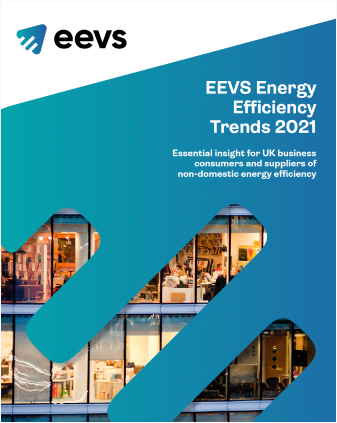By Hilary Wood, director, EEVS
As published in Estates Gazette February 2021
Too much attention at the start of the pandemic was focused on the alleged death of the office. Three lockdowns later and with vaccination rollout in gear, the focus has rightly moved to considering hybrid working models and the workplace strategies that will underpin this, re-energising staff and boosting productivity.
Questions about energy usage and the carbon performance of offices with currently low occupancy levels have perhaps not been front and centre for many businesses, as they consider new operating models and the shape and scale of their property requirements. But against the backdrop of a climate emergency and with many corporate and public sector occupiers declaring net zero commitments, it’s important that they are considered.
This is because there is a potential scenario in which increased energy usage will lead to a carbon rebound, as people return to offices as lockdown is eased and vaccination continues. Property, sustainability and energy teams are already focused on how their real estate strategy aligns with their corporate net zero vision. But they need to do this by preparing for a carbon rebound and, crucially, should now be making plans to mitigate it.
What’s the driver? Building operators seeking to create safe working environments are likely to require more from their ventilation systems. The German government has already said ventilation was “one of the cheapest and most effective ways” to contain the spread of the virus and some healthcare professionals have called for ‘hands, face, space and ventilate.’ We will see more innovation in ventilation, and the subsequent installation of more sophisticated systems in buildings. We can therefore expect to see ventilation technology play a greater role in the buildings of the near future.
Crucially, ventilation will be used more energy intensively. Some offices are now operating ventilation over a 24-hour period and switching to 100 per cent fresh air, rather than a mix of fresh and re-circulated air – both of which are already driving up consumption. For example, there are some offices that have 80 per cent less staff but are only saving 10 per cent of energy compared to before the pandemic.
The reality is that you can’t just turn buildings off. There is a clear need for assets to be professionally managed even when occupancy is low, so that heating and cooling systems are operating sufficiently, as well as to prevent water stagnation which can lead to legionella.
Conversely, for many offices during lockdown the average energy consumption has been at a level usually associated with weekend use. With a shift to home working, selected sites have effectively been ‘hibernated’ for the lockdown period. The carbon and cost savings have been significant.
What in practical terms should property teams consider to mitigate the impact of increased energy usage?
When businesses consider the new workspace strategy for different occupancy levels, they should think about the energy dimension to that as well. Yes, space utilisation is key for a world where there is a need for new collaboration spaces and quiet areas for virtual meetings, but in many buildings it might not be practical or efficient to operate all floors and disperse people around the building.
The days of every floor in a multi storey office being operational every day of the week might be over. Smart controls and understanding the performance data of offices and space usage will need to come to the fore.
To deliver meaningful action on carbon and energy consumption requires better reporting. Corporate reporting for many businesses is going to be notched up to higher levels because of the Government’s commitment to mandate carbon disclosure for listed and large private business.
Independent assessment of energy performance across a property portfolio is going to be crucial. The reality is that many businesses do not have a detailed understanding of energy performance or cost saving across their portfolio.
There are several examples of FTSE-100 companies successfully incentivising their facilities management (FM) providers to save energy across their estates. How they structure these innovative contracts – with their FM’s paid to manage the energy consumption of buildings, including the operation of the internal environment – is key. Performance-based contracts incorporating financial rewards for over-performance provide a tried-and-tested solution. They also represent an area of significant untapped potential for both occupiers and outsource facilities management providers.
Beyond putting in place appropriate contracts, there is a need for clients to have energy and cost saving initiatives independently verified. A detailed qualitative and quantitative assessment of all the methodologies and calculations used to generate a savings figure is essential if an occupier is to truly understand how it has been calculated.
This independent verification is important to provide greater certainty and transparency. This will be important for robust carbon reporting and understanding at a granular detail where the energy savings or increases are happening. Get all that right and you can fully understand the performance of a building and wider office portfolio. We’re living in a time of unprecedented change and a climate emergency. Businesses are going to adjust to new working models and the death of the office is greatly exaggerated. But buildings in the age of Covid-19 will need increased ventilation and therefore energy. As more business consider a return to the office, let’s do everything we can to prevent a carbon rebound
Read our latest Energy Efficiency Trends report
The research was undertaken between April and June 2021 and completed by 69 UK-based respondents, including 33 participants from organisations consuming energy efficiency products/services and 36 participants from suppliers of energy efficiency products and services.

Related Posts
Net zero: how can occupiers tackle property’s ‘long tail’?
By Ian Jeffries, Managing Director, EEVS
Here’s a statement that we all know: in the transition to net zero all property teams should be considering how can they drive energy efficiency across their portfolio. But where should that focus be? Undoubtedly the initial attention for many businesses with a large estate might be to focus on their top fifty largest sites by energy consumption.



